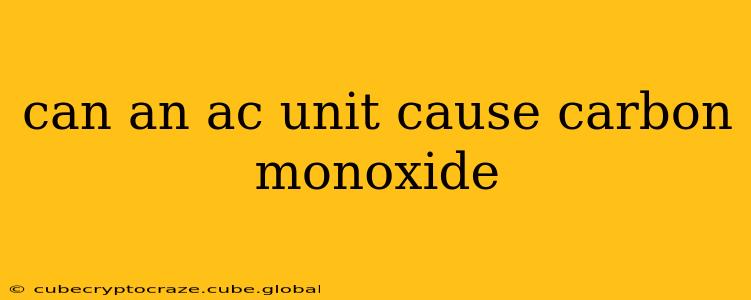Can an AC Unit Cause Carbon Monoxide?
The short answer is: generally, no, a properly functioning air conditioner does not produce carbon monoxide (CO). However, there are some indirect ways an AC unit can be related to CO issues, making it crucial to understand the potential risks and preventative measures.
Let's delve deeper into the specifics and address some common questions surrounding AC units and carbon monoxide.
How Does Carbon Monoxide Form?
Carbon monoxide is a poisonous, odorless, colorless gas produced when fuels like natural gas, propane, oil, or wood don't burn completely. This incomplete combustion happens when there's insufficient oxygen. Appliances that burn fuel, such as furnaces, water heaters, gas stoves, and even cars, can release CO if they malfunction or aren't properly ventilated.
Can My AC Unit Directly Produce Carbon Monoxide?
Standard air conditioners, whether window units, split systems, or central air, don't burn fuel. They use electricity to cool the air. Therefore, they do not directly produce CO as a byproduct of their operation.
So Why Might Someone Associate CO with Their AC Unit?
The connection between AC units and CO poisoning is usually indirect and stems from other appliances or factors within the home. Here are some scenarios:
- Simultaneous Appliance Malfunction: A faulty furnace or gas water heater located near the AC unit might release CO. The AC's operation itself is unrelated, but its proximity could lead to CO buildup in that area of the home, making it seem like the AC is the culprit.
- Poor Ventilation: Inadequate ventilation in the home can allow CO from other sources to accumulate, regardless of whether the AC is running or not. An AC unit, especially a central unit, can sometimes exacerbate poor ventilation by not properly circulating fresh air, inadvertently contributing to CO concentration in a particular area.
- Blocked Vents: If the vents for your furnace or other gas-burning appliances are blocked, this can lead to incomplete combustion and CO production. This is an indirect effect, not related to the AC itself.
- Exhaust Issues: Problems with the exhaust system of your furnace or other appliances could cause CO to back up into your home. This is unrelated to your air conditioner's function.
What Are the Symptoms of Carbon Monoxide Poisoning?
Recognizing the symptoms of CO poisoning is crucial for prompt action. Symptoms can vary depending on the level of exposure and can mimic the flu:
- Headache
- Dizziness
- Weakness
- Nausea
- Vomiting
- Shortness of breath
- Confusion
- Chest pain
What Should I Do If I Suspect Carbon Monoxide Poisoning?
Get out of the house immediately and call emergency services (911 in the US). Fresh air is essential. Once you're safe, contact a qualified HVAC technician to inspect your home's appliances and ventilation system.
How Can I Prevent Carbon Monoxide Poisoning?
- Regular Appliance Maintenance: Schedule annual inspections and maintenance for all fuel-burning appliances by a qualified technician.
- CO Detectors: Install CO detectors on every level of your home, especially near bedrooms. Test them regularly and replace the batteries as needed.
- Proper Ventilation: Ensure adequate ventilation throughout your home.
- Never Use Gas-Powered Generators Indoors: This is a significant source of CO poisoning.
In conclusion, while an AC unit itself doesn't produce carbon monoxide, it's essential to be aware of indirect relationships and ensure your home's ventilation and appliances are properly maintained and functioning correctly to prevent CO poisoning. Regular maintenance and CO detectors are crucial for a safe and healthy home environment.
